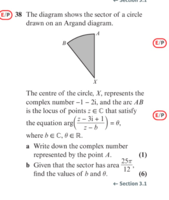

Hi, I am confused as to why XB is -5 sin pi/6 +5 cos pi/6. I understand Eulers formula but I cant see the angle [MATH]\theta[/MATH] would be the angle we need. I think it should be...well i am not sure. I think it should be angle that the XB makes with the horizontal axis. I am also unsure what the bar is above XB, I think it might be a notation for vector. Never seen it like that before, I have seen arrows on top of the alphabets which indicate direction vector. Maybe its like a vector but without direction. I know complex number can be thought of like vectors.
